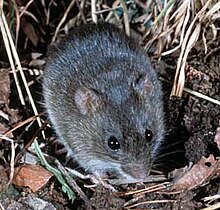Oryzomys peninsulae
O. peninsulae and another isolated population, O. nelsoni from the Islas Marías, were both retained as separate species, as was O. albiventer from montane mainland Mexico.[8] The genus Oryzomys currently includes about eight species distributed from the eastern United States (O. palustris) into northwestern South America (O. gorgasi).[19] Río San José no longer exists, having fallen prey to irrigation projects, and touristic development of its estuary has resulted in pollution.The lack of records for over a century, small distribution, and destruction of the only known habitat led Carleton and Arroyo-Cabrales to consider the conservation status of O. peninsulae as "critically endangered, if not extinct".In 1922, Nelson suggested that it may have been introduced from another part of Mexico in a shipment of farm products, but this hypothesis is disproved by the clear differentiation from other western Mexican Oryzomys that the species exhibits.

Conservation statusCritically endangeredIUCN 3.1Scientific classificationEukaryotaAnimaliaChordataMammaliaRodentiaCricetidaeSigmodontinaeOryzomysBinomial nameThomasSynonymsrodentMexicoBaja California peninsulaextinctionbraincasezygomatic archesincisive foraminapalateincisorsmolarsOldfield ThomasO. couesiO. palustrisPhilip HershkovitzRaymond HallclassifiedTamaulipassubspeciesmorphologicalmorphometricalO. nelsoniIslas MaríasO. albiventermontaneUnited StatesSouth AmericaO. gorgasisystematicsOryzomyiniorthodontSanta AnitaEdward William NelsonEdward Alphonso GoldmanSan José del CaboBaja California Sursemiaquaticlumpedmarsh rice ratintroducedrelictualGulf of CaliforniaSonoradisjunct distributionraftingMioceneNayaritJaliscobiogeographicInternational Code of Zoological NomenclatureligatureIncorrect subsequent spellingOryzomyini (rice rats)AegialomysA. galapagoensisA. xanthaeolusAgathaeromysA. donovaniA. praeuniversitatisAmphinectomysA. savamisCarletonomysC. cailoiCerradomysC. goytacaC. langguthiC. maracajuensisC. marinhusC. scottiC. subflavusC. vivoiDrymoreomysD. albimaculatusEremoryzomysE. poliusEuryoryzomysE. emmonsaeE. lamiaE. legatusE. macconnelliE. nitidusE. russatusHandleyomysH. alfaroiH. chapmaniH. fuscatusH. intectusH. melanotisH. rhabdopsH. rostratusH. saturatiorHolochilusH. brasiliensisH. chacariusH. sciureusHylaeamysH. acritusH. laticepsH. megacephalusH. oniscusH. perenensisH. tateiH. yunganusLundomysL. molitorMegalomysM. audreyaeM. curazensisM. desmarestiiM. georginaeM. luciaeMelanomys